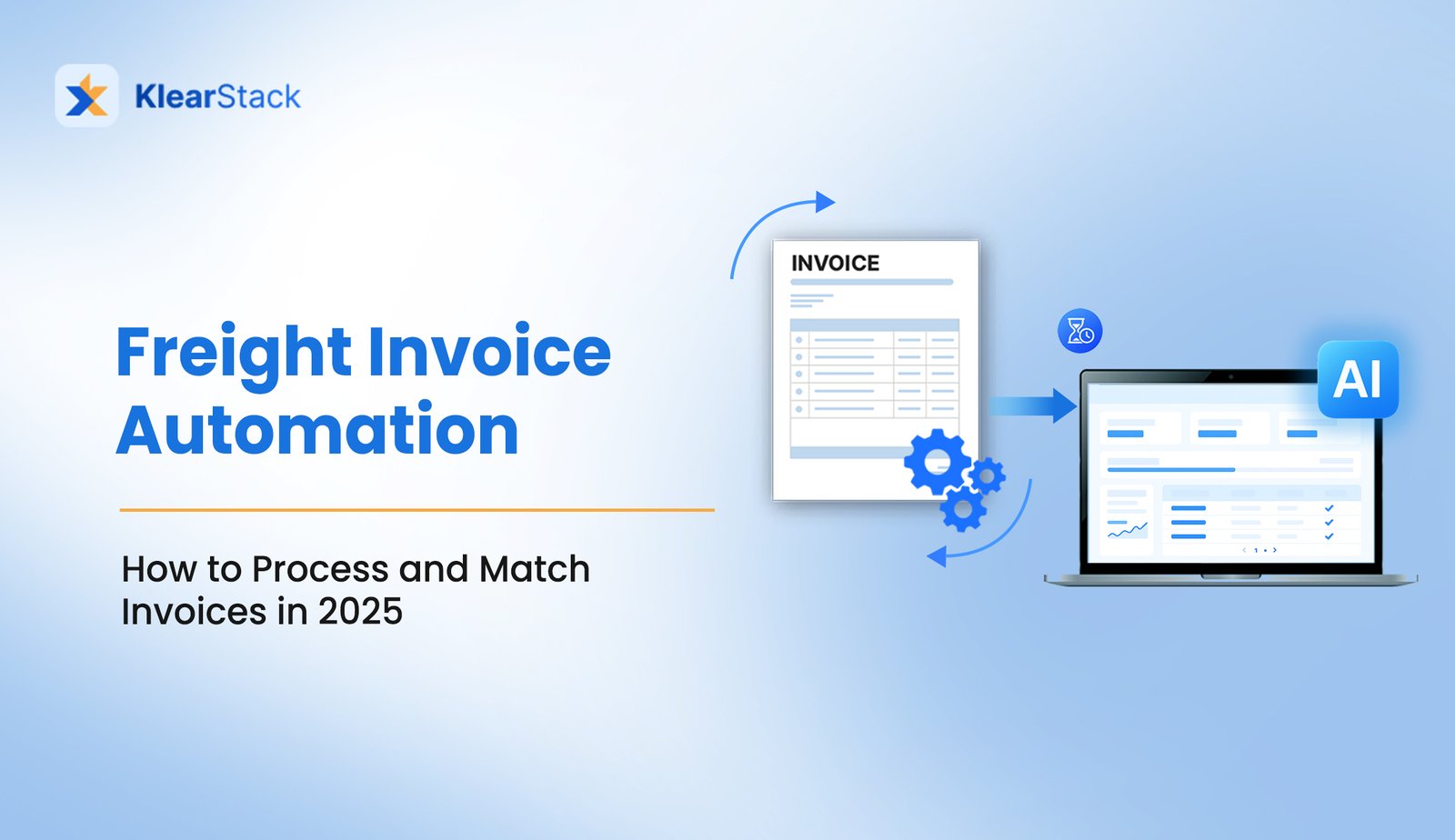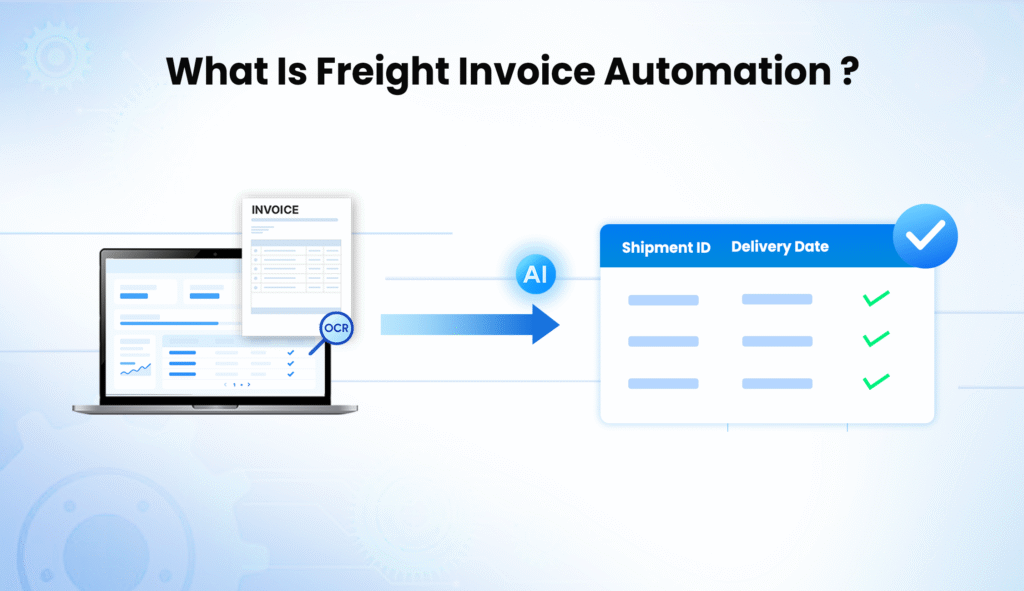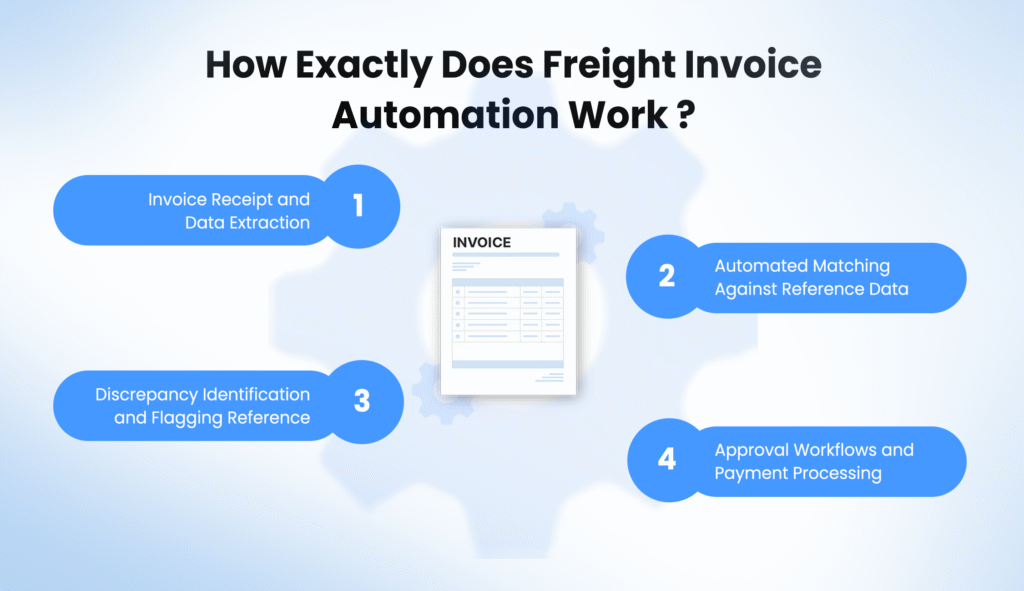Freight Invoice Automation: How to Process and Match Freight Invoices in 2025

Freight invoicing errors cost businesses up to $10.6 billion annually, with manual processing contributing to payment delays and strained carrier relationships. Finance teams handle thousands of invoices monthly, each requiring validation against rate cards, shipment records, and contract terms. A single billing discrepancy can delay payments by weeks, affecting both cash flow and vendor trust.
- How many hours does your team spend cross-checking freight charges against contracted rates?
- What happens when accessorial fees appear on invoices without proper documentation?
- Can your current system catch duplicate invoices before they reach payment approval?
Freight invoice automation addresses these pain points by replacing manual verification with AI-powered data extraction and validation. This technology processes invoices in minutes rather than hours, identifies billing errors automatically, and provides real-time visibility into payment status.
Organizations implementing automation report faster payment cycles, improved carrier relationships, and better cost control across their supply chain operations.
Key Takeaways
- Freight invoice automation reduces manual processing time from 30 minutes per invoice to under 60 seconds through AI-powered data extraction and validation
- Automated systems identify billing discrepancies by comparing actual charges against rate cards, contracts, and historical data in real time
- Invoice matching automation handles multiple document formats including PDFs, spreadsheets, and EDI transmissions without manual data entry
- Organizations processing high invoice volumes achieve better accuracy by eliminating human errors in data entry and calculation
- Integration with transportation management systems and ERP platforms creates automated workflows from invoice receipt to payment approval
- Real-time dashboards provide visibility into invoice status, dispute resolution progress, and cost recovery opportunities
- Automated audit trails maintain compliance documentation and support dispute resolution with carriers through complete transaction history
What Is Freight Invoice Automation

Freight invoice automation applies technology to extract, validate, and process freight (career) invoices without manual intervention. This process converts paper or digital invoices into structured data that systems can verify against contracted rates and shipment records.
Traditional freight invoice processing requires teams to manually enter data from freight (career) invoices, check charges against rate agreements, and flag discrepancies for review. Each invoice contains multiple data points including shipment IDs, weight measurements, delivery dates, base rates, fuel surcharges, and accessorial charges. Manual validation of these elements introduces errors and delays payment cycles.
Automated systems use optical character recognition and artificial intelligence to read invoice data regardless of format. The technology identifies key fields, extracts relevant information, and structures the data for validation.
This happens within seconds of invoice receipt, whether documents arrive via email, EDI transmission, or direct upload to processing platforms.
Core Components of Automated Processing
- Data capture technology reads freight invoices across multiple formats. Systems process PDFs from email attachments, XML files from EDI connections, and images from scanned documents. The technology recognizes text in various layouts, handling both standardized carrier formats and non-standard invoice designs.
- Validation engines compare extracted data against multiple reference sources. The system checks shipment IDs against transportation management system records, verifies rates against contracted pricing, and flags charges that exceed agreed terms. This comparison happens automatically without manual lookup or calculation.
- Exception handling workflows route discrepancies to appropriate reviewers. When the system identifies a billing error or missing information, it creates a task for the relevant team member. The workflow includes context about the issue, reference to source documents, and tools for resolution.
Automation transforms freight invoice processing from a labor-intensive manual task into an intelligent system that handles routine validation while escalating genuine issues for human review.
How Exactly Does Freight Invoice Automation Work?

Automated freight invoice processing follows a defined sequence that moves documents from receipt to payment approval. Each step builds on the previous one, creating a complete validation path for every invoice.
Step 1: Invoice Receipt and Data Extraction
Systems receive freight invoices through multiple channels. Email attachments arrive directly in processing queues, EDI connections pull data from carrier systems, and users upload documents through web interfaces. The platform accepts all common formats, including PDFs, CSV files, Excel spreadsheets, and image files.
Intelligent document processing reads invoice content regardless of layout. The technology locates critical fields like invoice numbers, shipment identifiers, carrier information, and charge breakdowns. For complex invoices with multiple pages or non-standard formats, the system uses machine learning to understand document structure and extract relevant data.
Step 2: Automated Matching Against Reference Data
The system compares extracted invoice data against three primary sources.
- First, it matches shipment IDs with records in the transportation management system to confirm delivery completion.
- Second, it validates charges against rate cards and contracts to verify pricing accuracy.
- Third, it checks for duplicate submissions by comparing invoice numbers and amounts against historical payment records.
Three-way matching creates the standard validation approach. The process verifies that invoice charges match both the original quotation and the goods receipt confirmation.
For organizations requiring higher validation levels, four-way matching adds inspection reports to confirm shipment quality before payment approval.
Step 3: Discrepancy Identification and Flagging
Validation rules identify common billing errors. The system flags charges that exceed contracted rates, accessorial fees not authorized in advance, weight discrepancies between bills of lading and invoices, and duplicate invoice submissions.
Each flagged item includes details about the specific variance and supporting documentation.
Exception categories determine routing paths:
- Rate variances above tolerance thresholds go to freight audit teams
- Missing reference documents route to operations for shipment confirmation
- Duplicate invoices trigger automatic rejection with carrier notification
- Unauthorized charges require procurement approval before payment
Step 4: Approval Workflows and Payment Processing
Validated invoices flow through approval hierarchies based on amount thresholds and business rules. Small variances within acceptable tolerance move directly to payment queues.
Larger discrepancies require manager approval before processing. The system maintains audit trails showing who approved each invoice and when approval occurred.
Payment integration connects automated invoice processing with accounts payable systems. Approved invoices transfer to ERP platforms with complete supporting documentation.
The system schedules payments according to terms, tracks payment status, and updates carrier portals with payment confirmations.
This automated sequence handles thousands of invoices monthly while maintaining consistent validation standards across all carrier relationships.
Benefits of Freight Invoice Automation
Automated freight invoice processing delivers measurable improvements across operations. Organizations report faster cycles, better accuracy, and clearer cost visibility after implementation.
1. Processing Speed Increases
Manual validation takes 20 to 30 minutes per invoice. Staff locate shipment records, verify rate cards, and enter payment data. Automation completes identical validation in under 60 seconds.
Companies processing 5,000 monthly invoices save approximately 2,400 hours each month. Teams redirect this capacity toward carrier performance analysis, rate negotiations, and cost optimization rather than repetitive data entry.
2. Billing Accuracy
Data entry errors occur in 1-2% of manually processed invoices. Common mistakes include transposed numbers, missed decimals, and incorrect rate applications that lead to overpayments.
Automated systems apply consistent validation logic across every document. The technology eliminates variations caused by staff experience or workload pressure, maintaining accuracy rates exceeding 98% regardless of invoice volume.
3. Payment Cycles Accelerate From Weeks to Days
Processing delays strain carrier relationships. When invoices take weeks to approve, carriers face payment uncertainty that affects pricing negotiations and service prioritization.
Automation moves invoices from receipt to approval in days rather than weeks. Faster cycles enable early payment discount capture while predictable schedules improve carrier trust and strengthen partnerships.
4. Cost Visibility Improves Through Real-Time Data
Manual processing offers limited spending insights. Teams validate individual invoices without analyzing patterns across carriers, lanes, or service types that reveal optimization opportunities.
Automated systems capture detailed cost data from every invoice. Dashboards display spending trends, flag cost increases, and identify savings opportunities without waiting for month-end reports. Finance teams respond to budget variances immediately.
Key Features of Freight Invoice Automation Systems
Effective automation platforms share common capabilities that address core freight invoice processing requirements. These features work together to create complete processing workflows.
Intelligent Document Processing
Modern freight invoice automation uses AI to understand invoice content. The technology reads various document formats including PDFs, images, spreadsheets, and structured data files.
Unlike template-based systems that require configuration for each carrier format, intelligent processing adapts to new invoice designs automatically.
The system identifies relevant fields through contextual understanding. It recognizes that “freight charge,” “transportation fee,” and “shipping cost” refer to the same concept even when carriers use different terminology. This flexibility eliminates the need for manual template creation and maintenance.
Multi-Way Invoice Matching
Automated matching verifies invoice accuracy through comparison with reference documents. Two-way matching compares invoices against purchase orders or rate quotations.
Three-way matching adds proof of delivery to confirm shipment completion. Four-way matching includes quality inspection reports for added validation.
Organizations configure matching rules based on shipment value, carrier relationships, and risk tolerance. High-value shipments typically require three or four-way matching while routine deliveries may use two-way validation.
The system applies these rules consistently across all invoices without manual decision-making.
Real-Time Dashboard and Reporting
Processing visibility enables proactive management. Dashboards display current invoice status, pending approvals, outstanding disputes, and payment schedules. Teams see which invoices require attention without manually checking multiple systems.
Analytics capabilities reveal patterns in invoice data:
- Carrier performance metrics including on-time delivery and billing accuracy
- Cost trends by lane, service level, and time period
- Common dispute causes and resolution timeframes
- Payment term compliance and discount capture rates
Integration With Existing Systems
Freight invoice automation connects with transportation management systems, ERP platforms, and accounting software. These integrations enable automatic data flow between systems without manual file transfers or data re-entry.
APIs provide flexible connection options. The automation platform can pull shipment data from TMS systems for validation, push approved invoices to accounts payable systems for payment, and update carrier portals with payment status. This connected approach creates seamless processing from invoice receipt through payment completion.
Configurable Approval Workflows
Different invoice types require different approval processes. Organizations define rules that route invoices based on amount, carrier, variance level, or other criteria.
Small invoices within tolerance may receive automatic approval while larger amounts or disputed charges require management review.
The workflow system maintains approval history for audit purposes. Each invoice record shows who approved payment, when approval occurred, and what supporting information the approver reviewed. This complete audit trail supports both internal controls and external audits.
These features combine to create processing systems that handle routine validation automatically while providing tools for managing exceptions and maintaining compliance.
Why Should You Choose KlearStack for Freight Invoice Automation?

Logistics operations demand reliable document processing that handles high volumes while maintaining accuracy. Your current manual processing creates bottlenecks in payment cycles and limits visibility into transportation costs.
KlearStack transforms freight invoice management through intelligent automation. Our platform processes carrier invoices from any format without template configuration. The system learns from each document, improving accuracy with every invoice processed.
Processing capabilities that matter:
- Template-free extraction adapting to any carrier invoice format
- Self-learning AI that improves validation accuracy over time
- Multi-way matching against shipments, contracts, and rate cards
- Automated exception handling with intelligent routing
- Real-time dashboards showing payment status and cost trends
Results you can measure:
Handle 10,000+ invoices daily with consistent processing speed. Our AI achieves 99% extraction accuracy across all document types and formats. Organizations using KlearStack reduce invoice processing time by 80% while improving billing accuracy.
KlearStack integrates with your existing transportation management and ERP systems. We support secure data handling that meets industry compliance standards. Your team gains complete visibility into invoice status, dispute resolution, and carrier performance.
The platform handles complex freight scenarios including fuel surcharge calculations, accessorial fee validation, and multi-currency processing. Our intelligent field extraction works with varying invoice layouts without manual configuration.
Ready to reduce freight invoice processing time and improve payment accuracy? Book a Free Demo Call
Conclusion
Freight invoice automation eliminates manual processing bottlenecks that delay payments and create billing errors. Organizations implementing AI-powered invoice processing report faster payment cycles, improved carrier relationships, and better visibility into transportation costs.
The technology handles document format variations, validates charges against multiple reference sources, and maintains complete audit trails for compliance.
Organizations gain operational capacity by redirecting staff from repetitive data entry to strategic supply chain optimization.
FAQs
Freight invoice automation uses AI and optical character recognition to extract data from carrier invoices automatically. The system validates charges against rate cards and shipment records without manual processing.
Implementation typically requires 4-8 weeks including system configuration, data integration, and staff training. Organizations processing higher invoice volumes may need additional time for custom rule development.
Yes, intelligent document processing adapts to various invoice layouts without templates. The technology recognizes relevant fields regardless of format, handling PDFs, spreadsheets, and EDI transmissions.
AI-powered systems achieve 98-99% accuracy in data extraction and validation. This exceeds manual processing accuracy while eliminating errors from data entry and calculation mistakes.


